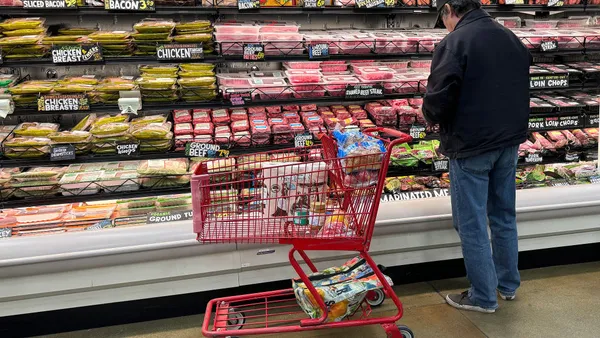Dive Brief:
- Meat and poultry sales grew 34.6% from mid-March through July compared to the same period last year, with beef in particular generating new revenue, according to the latest "Power of Meat" study published by the Food Industry Association (FMI) and the Foundation for Meat and Poultry Research and Education.
- The study, prepared by marketing research firm 210 Analytics, found that around 48% of shoppers surveyed purchased more meat during the first half of the year, reflecting an influx in at-home meals after restaurant and hospitality industries shut down. 210 Analytics surveyed 1,000 shoppers who were the primary household shopper or equally responsible for household grocery shopping, and only meat eaters and flexitarians were surveyed.
- Shelter-in-place orders drew consumers toward supermarkets and online sellers to limit their store visits, but 52% of those surveyed said they would return to their usual store to buy meat products after the pandemic.
Dive Insight:
Among the slew of findings on consumer meat-buying habits are indications that short-term supply chain issues might actually translate into long-term positive developments for grocers.
Although a small majority of shoppers whose shopping habits changed during the pandemic toward supermarket or online orders said they would revert back post-pandemic, nearly two-thirds of consumers said their knowledge about meat and cooking meat has improved since March.
For a segment where set shopping routines and a lack of buying confidence are significant barriers to growth, the findings that consumers have greater comfort and are experimenting more with different cuts of meat is significant. It also indicates that innovations in meat cut selections can pay off for grocers when experiencing meat shortages. As Bob LaBonne Jr., president and CEO of LaBonne’s Markets told Grocery Dive in May, his decision to take cuts of meat that were the wrong size or imperfect from his suppliers allowed him to provide his customers with a greater variety.
Fifty-eight percent of consumers surveyed said they predict that they will continue to buy a wider variety of meat and poultry items even once supply adjusts to influxes in demand. Offering cheaper meat and poultry products could be particularly advantageous for grocers, as 46% of shoppers surveyed said that they changed cuts to save money.
Indeed, meat-eaters and flexitarians appeared to be more comfortable substituting other cuts of meat when their preferred product was unavailable than they were switching to a plant-based substitute: 51% bought a different type of meat or poultry when experiencing out-of-stocks, while just 11% bought a plant-based meat alternative.
Despite the low percentage shift to plant-based meat reflected in this survey, the category has grown faster in grocery than conventional meat products during the coronavirus pandemic. It may be the case that this popularity was more significant among vegetarians, whose shopping habits were excluded from the FMI report, or that survey takers' shopping habits already incorporate plant-based meat.
Just two-thirds of consumers said they believe that meat belongs in a happy and balanced diet, pointing to a marketing angle for plant-based products, which have been found to perform better when sold in grocery store meat sections. However, the findings by 210 Analytics that meat-eaters and flexitarians have become increasingly comfortable with cooking with other cuts of meat could pose a hurdle for plant-based meat sellers looking to attract flexitarians as they expand into retail.
COVID-19 outbreaks at several major meatpacking plants this summer created difficulties for supply chains and contributed to category inflation, and a recent surge in cases means the industry’s supply chain issues may not yet be in the rearview mirror. This could mean an opportunity to broaden customers’ comfort zones, or, if grocers fail to adapt, lose sales to competing stores or online sellers.








